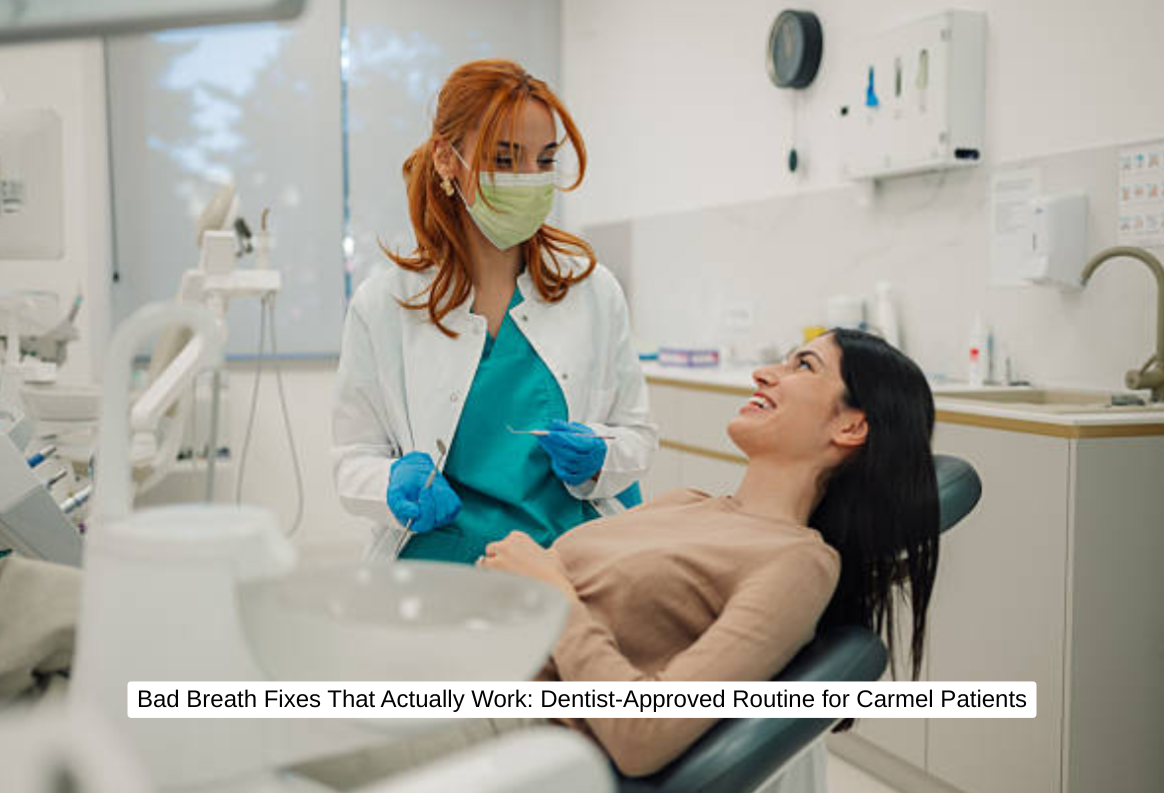Let's be honest: you've probably tried breath mints, chewed gum until your jaw hurt, or brushed your teeth three times before an important meeting. But what if those solutions are just masking a problem that needs a different approach? Research shows that 50% of adults deal with bad breath at some point, and the solutions that actually work might not be the ones you'd expect. Water flossers and tongue cleaners aren't just trendy tools making the rounds on social media. They're addressing the actual source of bad breath in ways that regular brushing and mouthwash can't reach.
Why Your Current Routine Might Not Be Enough
Your toothbrush does excellent work on the surfaces of your teeth. But according to the American Dental Association, bad breath most often starts when food particles collect on the tongue's surface, between teeth, or along the gum tissue. These areas create perfect hiding spots for bacteria that produce sulfur compounds, which are responsible for that unpleasant odor.
Think of it this way: if you're only cleaning the visible parts of your teeth, you're missing the neighborhoods where the real troublemakers hang out. The spaces between your teeth and the bumpy surface of your tongue are like bacterial apartment complexes, and standard brushing can't evict all the residents.
Water Flossers: More Than Just a Fancy Gadget
Here's something that might surprise you about water flossers. Studies show that water flossers remove 29% more plaque than traditional string floss. That's not a minor difference when you're trying to get rid of the bacteria causing your breath problems.
Water flossers work by shooting a pressurized stream of water between your teeth and along your gumline. This pulsating water disrupts plaque and washes away bacteria from hard-to-reach areas that brushing alone struggles to access. For people in Carmel dealing with persistent breath issues, this deeper clean can make a real difference.
The benefit goes beyond just removing food particles. Water flossers improve gum health by being effective yet gentle, and they can help decrease bleeding and tighten gum tissue. Healthier gums mean fewer pockets where odor-causing bacteria can settle in for the long haul.
If you have braces, bridges, or dental implants, a water flosser becomes even more valuable. It can clean around these dental appliances without the awkward threading and maneuvering that traditional floss requires. And if you're one of those people who finds regular flossing uncomfortable or difficult, water flossing might be the solution that gets you to actually do it daily.
Tongue Cleaners: Targeting the Biggest Source
Your tongue deserves more attention than it's probably getting. The back of the tongue, with its irregular surface full of papillae and fissures, is the most important reservoir for bacteria that produce volatile sulfur compounds. Translation: that bumpy surface on your tongue is prime real estate for the bacteria causing bad breath.
Research confirms that mechanical tongue cleaning significantly reduces both bad breath and the coating on your tongue. The interesting part? It doesn't matter much whether you use a tongue scraper, a tongue brush, or even your toothbrush. What matters is that you're actually cleaning back there, and doing it regularly.
Here's the technique that works: start as far back on your tongue as comfortable (without triggering your gag reflex), and scrape or brush forward toward the tip. Studies have shown that tongue cleaning can remove up to 75-90% of the bacteria contributing to bad breath. That's substantial when you're trying to tackle the problem at its source.
Some people swear by metal tongue scrapers because they're durable and easy to clean. Others prefer the softer feel of plastic or silicone options. The best choice is simply the one you'll use consistently.
Building Your Bad Breath-Fighting Routine
Now that you know what tools work, let's talk about how to put them together into a routine that fits into your real life. Nobody wants a 30-minute oral care session twice a day, so here's what actually makes sense:
Morning routine: Brush your teeth for two minutes, paying attention to all surfaces. Then clean your tongue from back to front. Finish with your water flosser to clear out anything between your teeth. The whole process takes about five minutes and sets you up with fresh breath for the day.
Evening routine: Same steps, but this is when thoroughness really counts. The American Dental Association recommends brushing twice daily with fluoride toothpaste and cleaning between teeth once daily. The evening session is your chance to remove everything that's accumulated throughout the day.
After meals: If you can, rinse your mouth with water and chew sugar-free gum. This helps stimulate saliva production, which naturally fights bacteria. Saliva helps kill bacteria and removes excess food particles from your mouth, so keeping it flowing is part of the solution.
When to See Your Dentist in Carmel
Sometimes bad breath signals something that needs professional attention. Infections in the mouth, such as tooth decay or gum disease, can contribute to bad breath. If you've upgraded your routine with water flossers and tongue cleaning but still notice persistent breath problems, it's time to schedule an appointment at SmileCentric - Cosmetic Dentist / Dental Implant Center.
Dr. Louis Abukhalaf notes, "We often see patients who've tried everything for bad breath, only to discover it was linked to gum disease or a hidden cavity. Once we address the underlying issue and help them establish the right cleaning routine, the problem resolves completely. It's incredibly rewarding to see their confidence return."
The team at SmileCentric understands that breath concerns can affect your confidence in social situations, at work, and in your daily life. They take the time to identify the root cause rather than just recommending another mouthwash.
Beyond the Basics: Other Factors to Consider
Sometimes bad breath isn't just about oral hygiene. Certain diets, like the ketogenic diet, can cause halitosis because when your body is in ketosis, it releases acetone which has a distinct odor. Caffeine and alcohol can reduce saliva production, creating an environment where bacteria thrive.
Dry mouth is a common cause of bad breath, and it can result from medications, breathing through your mouth at night, or simply not drinking enough water throughout the day. Indiana winters can be particularly drying, so staying hydrated becomes even more important for Carmel residents during those months.
Smoking doesn't just stain your teeth and increase your risk of gum disease. It also dries out your mouth and creates an odor that no amount of mints can fully mask. If you're serious about addressing bad breath, quitting tobacco is one of the most effective steps you can take.
Choosing Your Tools
When shopping for a water flosser, look for one with adjustable pressure settings. This lets you start gentle if you have sensitive gums and increase the intensity as you get comfortable with the device. Some models even come with special tips designed for cleaning around braces or implants.
For tongue cleaners, the choice comes down to personal preference and what feels comfortable in your mouth. Metal scrapers tend to last longer and are easy to keep clean. Plastic options are often more flexible and gentler if you have a sensitive gag reflex. Some electric toothbrushes even include tongue-cleaning attachments on the back of the brush head.
Remember that these tools need regular cleaning too. Rinse your water flosser reservoir and tips after each use, and replace the tips according to the manufacturer's recommendations. Clean your tongue scraper with soap and hot water, and let it air dry between uses.
The Role of Professional Cleanings
Even with the best at-home routine, professional cleanings at SmileCentric - Cosmetic Dentist / Dental Implant Center remain important. Most people should visit their dentist every six months for a thorough cleaning and evaluation. These appointments remove tartar that can't be eliminated at home and catch any developing issues before they become bigger problems.
During your cleaning, the hygienist reaches areas that are challenging to clean on your own, no matter how good your technique. They can also show you any spots you might be missing in your daily routine and adjust your approach based on your specific mouth geography.
If you're dealing with gum disease, SmileCentric offers treatments that go beyond routine cleanings. From deep cleanings to more advanced periodontal care, they have solutions that address the underlying causes of persistent bad breath.
Making It Stick
The best oral hygiene routine is the one you'll actually do consistently. Start by adding just one new element, whether that's the water flosser or tongue cleaner. Use it for a week until it becomes automatic. Then add the second tool once the first one feels like a habit.
Keep your tools visible on your bathroom counter rather than hidden in a drawer. Out of sight really does mean out of mind when it comes to forming new habits. Consider setting a reminder on your phone for the first few weeks until the routine becomes second nature.
Track your progress by paying attention to how your mouth feels when you wake up. Morning breath is normal due to reduced saliva production during sleep, but you should notice improvement in the severity once you've been consistent with tongue cleaning and water flossing.
FAQs
How long does it take to see results from using a water flosser and tongue cleaner?
Most people notice fresher breath within the first week of consistent use. However, the reduction in bad breath from tongue cleaning is short-term, which means daily use is necessary for ongoing results. Think of it like showering—the benefits last until bacteria rebuild, which is why consistency matters.
Can water flossers damage my gums?
Water flossers are gentle on gums when used properly. Start with the lowest pressure setting and gradually increase as your gums become accustomed to the sensation. If you experience bleeding that persists beyond the first few uses, schedule an appointment at SmileCentric - Cosmetic Dentist / Dental Implant Center to rule out gum disease.
Should I use my water flosser before or after brushing?
Use it after brushing. This removes any particles that brushing loosened but didn't eliminate. Some people also like to use it before brushing to clear out larger debris, then finish with another quick water floss afterward. Either approach works as long as you're using both tools daily.
Do tongue scrapers work better than brushing your tongue with a toothbrush?
Research shows that both methods effectively reduce bad breath and tongue coating, with no significant difference between tools. The key is using whichever tool you prefer, as long as you're cleaning your tongue daily from back to front. Some people find scrapers less likely to trigger their gag reflex than brushing.
How often should I replace my tongue scraper?
Replace plastic tongue scrapers every 3-4 months, similar to your toothbrush. Metal scrapers can last for years with proper cleaning, but inspect them regularly for any damage or rough edges that could irritate your tongue.
Can bad breath ever signal a serious health problem?
Yes. Bad breath can indicate health conditions including respiratory infections, diabetes, chronic acid reflux, or liver and kidney problems. If improving your oral hygiene doesn't resolve persistent bad breath, see your doctor or dentist to rule out underlying medical issues. The team at SmileCentric takes a comprehensive approach to diagnosing breath problems that don't respond to improved oral care.
Want to get your breath concerns under control? Schedule an appointment at SmileCentric - Cosmetic Dentist / Dental Implant Center in Carmel to discuss a personalized treatment plan. Their combination of modern dental care and old-fashioned hospitality means you'll get solutions that actually work, delivered with the comfort and understanding you deserve.




